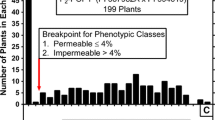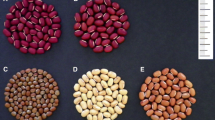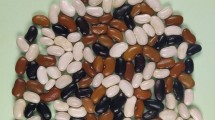Abstract
Seed coat wrinkling is a major factor affecting the germinability of soybean [Glycine max (L.) Merr.] seed produced in high-temperature environments, such as in the Early Soybean Production System of the midsouthern United States. Exposure of seed to high temperatures, coupled with alternating periods of wet and dry conditions, promotes seed coat wrinkling. This can predispose the seed to mechanical damage at harvest, further reducing germinability, and reducing the usability of the grain for seed beans. Previous studies identified a single recessive gene (shr) in a mutant line (T-311), located on chromosome 13 (linkage group F), which causes seed shriveling and seed coat wrinkling. The current study was undertaken to identify and genetically map new gene(s) that affect seed coat wrinkling. Crosses were made between a smooth-seeded accession (PI 567743) and a wrinkled-seeded accession (PI 87623). The parents, F1, F2, and BC1 generations were phenotyped for seed coat wrinkling in a greenhouse in Stoneville, MS during the summer of 2006. Genetic analysis indicated that the wrinkled seed coat trait in PI 87623 was inherited as a single recessive gene. A test for allelism, conducted in the greenhouse with a segregating F2 population derived from T-311 × PI 87623, showed that the gene from PI 87623 is different from the shr gene in T-311. A field study of a larger population, derived from a reciprocal cross of the same parents, confirmed these results, but also suggested epistatic interactions between the genes. A linkage map was developed using 195 SSR and SNP markers on 168 F2 individuals of the cross PI 567743 × PI 87623. Linkage analysis identified only one significant locus which was located on chromosome 5 (linkage group A1), confirming identification of a new gene that controls seed coat wrinkling in soybean. This study demonstrates genetic control of seed coat wrinkling, which offers the potential for selecting cultivars with less seed coat wrinkling for heat-stressed production environments.




Similar content being viewed by others
References
Baur ME, Boethel DJ, Boyd ML, Bowers GR, Way MO, Heatherly LG, Rabb J, Ashlock L (2000) Arthropod populations in early soybean production systems in the Mid-South. Environ Entomol 293:12–328
Bhattacharyya MK, Smith AM, Noel Ellis TH, Hedley C, Martin C (1990) The wrinkled-seed character of pea described by Mendel is caused by a transposon-like insertion in a gene encoding starch-branching enzyme. Cell 60:115–122
Chen Z, Shoemaker RC (1998) Four genes affecting seed traits in soybeans map to Linkage Group F. J Hered 89:211–215
Diers BW, Beilinson V, Nielsen NC, Shoemaker RC (1994) Genetic mapping of the Gy4 and Gy5 glycinin genes in soybean and the analysis of a variant of Gy4. Theor Appl Genet 89:297–304
Edwards JT, Purcel LC, Vories ED, Shannon JG, Ashlock LO (2003) Short-season soybean cultivars have similar yields with less irrigation than longer-season cultivars. Crop Manage. doi:10.1094/CM-2003-0922-01-RS
Egli DB, TeKrony DM, Heitholt JJ, Rupe J (2005) Air temperature during seed filling and soybean seed germination and vigor. Crop Sci 45:1329–1335
Fehr WR, Caviness CE (1977) Stages of soybean development. Iowa Agric. Exp. Stn. Spec. Rep. 80. Iowa State Univ., Ames
Franca Neto JB, Henning AS (1984) Qualidades fisiologicae sanitaria de sementes de soja. Circular Tecnica. Empresa Brasileira de Pesquisa Agropecuaria, Londrina, Brazil
Franca Neto JB, West SH, Vaughan WR (1988) Multiple quality evaluation of soybean seed produced in Florida in 1986. Soil Crop Sci Soc Fla Proc 47:20–206
Gibson LR, Mullen RE (1996) Soybean seed quality reductions by high day and night temperatures. Crop Sci 36:1615–1619
Heatherly LG (1993) Drought stress and irrigation effects on germination of harvested soybean seed. Crop Sci 33:777–781
Heatherly LG (1999) Early soybean production system (ESPS). In: Heatherly LG, Hodges HF (eds) Soyabean production in the midsouth. CRC Press, Boca Raton
Heatherly LG, Kenty MM (1995) Irrigation during seedfill and germinability of soybean with impermeable seed coat character. Crop Sci 35:205–208
Honeycut RJ, Burton JW, Shoemaker RC, Palmer RG (1989) Expression and inheritance of a shriveled seed mutant in soybean. Crop Sci 29:704–707
Hyten DL, Pantalone VR, Sams CE, Saxton AM, Landau-Ellis D, Stefaniak TR, Schmidt ME (2004) Seed quality QTL in a prominent soybean population. Theor Appl Genet 109:552–561
Jakkula LR, Knauft DA, Gorbet DW (1997) Inheritance of a shriveled seed trait in peanut. J Hered 38:47–51
Keith BC, Delouche JC (1999) Seed quality, production, and treatment. In: Heatherly LG, Hodges HG (eds) Soybean production in the midsouth. CRC Press, BocaRaton, pp 197–230
Landis RJ, Heyman ER, Koch GG (1978) Average partial association in three-way contingency tables: a review and discussion of alternative tests. Int Stat Rev 46:237–254
Liu K, Brown EA (1995) Fatty acid composition within each structural part and section of a soybean seed. J Agric Food Chem 43:381–383
Lobell DB, Schlenker W, Costa-Roberts J (2011) Climate trends and global crop production since 1980. Science 333:616–620. doi:10.1126/science.1204531
Mantel N, Haenszel W (1959) Statistical aspects of the analysis of data from retrospective studies of disease. J Natl Cancer Inst 22:719–748
Mengistu A, Heatherly LG (2006) Planting date, irrigation, maturity group, year, and environment effects on Phomopsis longicolla, seed germination, and seed health rating of soybean in the early soybean production system of the midsouthern USA. Crop Prot 25:310–317
Misra PS, Mertz ET, Glover DV (1975) Studies on corn proteins. VI. Endosperm protein changes in single and double endosperm mutants of maize. Cereal Chem 52:161–166
Palmer RG, Kilen TC (1987) Qualitative genetics and cytogenetics. In: Wilcox JR (ed) Soybean improvement, production and uses. Agronomy monograph, vol 16. American Society of Agronomy, Madison
Shewry PR, Williamson MS, Kreis M (1987) Effects of mutant genes on the synthesis of storage components in developing barley endosperms. In: Thomas H, Grieson D (eds) Developmental mutants in plants. Cambridge University Press, Cambridge, pp 95–118
Smith JR, Mengistu A, Nelson RL, Paris RL (2008) Identification of soybean accessions with high germinability in high-temperature environments. Crop Sci 48:2279–2288
Sokal RR, Rohlf FJ (1995) Biometry. The principles and practice of statistics in biological research, 3rd edn. WH Freeman, New York
SoyBase (2012) http://soybeanbreederstoolbox.org/
Spears JF, TeKrony DM, Egli DB (1997) Temperature during seed filling and soybean seed germination and vigour. Seed Sci Technol 25:233–244
Stombaugh SK, Jung HG, Orf JH, Somers DA (2000) Genotypic and environmental variation in soybean seed cell wall polysaccharides. Crop Sci 40:408–412
Tyler JM (1999) Note on variation in germinability among early-maturing soybean populations. Field Crops Res 62:177–180
USDA, ARS, National Genetic Resources Program, Germplasm Resources Information Network (GRIN) (2011) [Online Database] National Germplasm Resources Laboratory, Beltsville. Available: http://www.ars-grin.gov/cgi-bin/npgs/acc/search.pl?accid=PI+567743
USDA, ARS, National Genetic Resources Program, Germplasm Resources Information Network (GRIN) (2012) [Online Database] National Germplasm Resources Laboratory, Beltsville. Available: http://www.ars-grin.gov/cgi-bin/npgs/acc/search.pl?accid=PI+87623
Van Ooijen JW (2006) JoinMap® 4.0. Software for the calculation of genetic linkage maps in experimental populations. Wageningen
Van Ooijen JW (2009) MapQTL® 6.0. Software for the mapping of quantitative trait loci in experimental populations. Wageningen
Yates F (1934) Contingency table involving small numbers and the χ2 test. Suppl J R Stat Soc 1:217–235
Acknowledgments
The authors appreciate the dedicated work of the USDA-ARS personnel at Stoneville, MS, including Mr. Terry Steed in the greenhouse and field, and Ms. Angelie Davis in the lab. In Puerto Rico, we were ably assisted in seed production by Dr. Ricardo Goenaga and Mr. Carlos Torres of the USDA-ARS.
Author information
Authors and Affiliations
Corresponding author
Rights and permissions
About this article
Cite this article
Kebede, H., Smith, J.R. & Ray, J.D. A new gene that controls seed coat wrinkling in soybean. Euphytica 189, 309–320 (2013). https://doi.org/10.1007/s10681-012-0818-6
Received:
Accepted:
Published:
Issue Date:
DOI: https://doi.org/10.1007/s10681-012-0818-6




